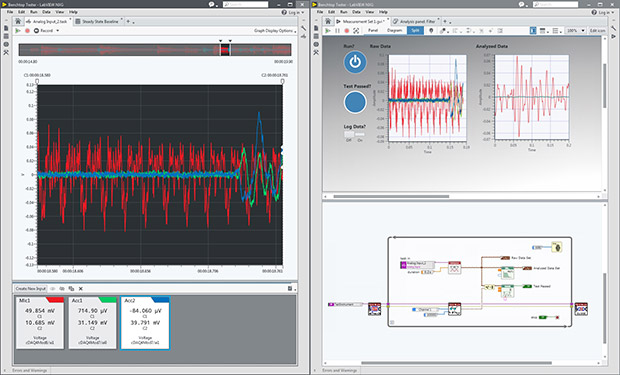Editor’s Pick: New Generations of LabVIEW Unveiled

An example of a professional-level engineering instrumentation system created in LabVIEW NXG 1.0. Image courtesy of National Instruments.
June 14, 2017
A revolution is afoot in how you work with engineering software—specifically, more powerful and more automated applications. Software is getting out of your way. This gives you more time to innovate because you’re spending less time developing programming expertise or setting up software for an assignment. Today’s Editor’s Pick of the Week is a fine example.
 An example of a professional-level engineering instrumentation system created in LabVIEW NXG 1.0. Image courtesy of National Instruments.
An example of a professional-level engineering instrumentation system created in LabVIEW NXG 1.0. Image courtesy of National Instruments.At its recent user conference, NI announced the 2017 version of its LabVIEW software for test, measurement, control, simulation, visualization and system design. LabVIEW doesn’t need an introduction. It’s a bright star in the galaxy of A-list engineering tools. But NI also introduced the next generation of LabVIEW. It looks like it quickly could take you where no one has gone before.
The official name for this emergent tool chest is LabVIEW NXG 1.0. It’s all about faster time to measurements and faster data set analyses and visualizations. And it’s about your productivity, too.
A key attribute to that end is that LabVIEW NXG has a no programming workflow to set up, acquire and visualize datasets. (Of note to experienced LabVIEW users, you can get down into the code if you need to.)
“No programming” means what? LabVIEW already is a pioneer in graphical programming to minimize fiddling around with code. LabVIEW NXG was designed from the ground up to go beyond that, according to NI. A key example is that LabVIEW NXG automatically discovers connected data acquisition devices and benchtop instruments. It’ll even help you search and install missing drivers.But linked with auto-discovery are interactive panels with the measurement types compatible with your hardware. You click a couple of times and you’re getting data. Really.
For coping and managing those wads of data you get, LabVIEW NXG has integrated data capture and analysis tools. You can capture snapshots of data streams, specify the type of analysis you want, store data in a central repository and export data for further analysis. Videos accessible from the first link at the end of today’s main write-up show you this in action.
Now, LabVIEW NXG 1.0 doesn’t yet offer all the add-on modules that make LabVIEW a go-to tool, but it will. It is evolution in progress. That said, it could be what you’re looking for already. NI has a quick test to help you determine that. Hit today’s Editor’s Pick of the Week link to learn more about LabVIEW NXG and how it continues LabVIEW’s mission.
Thanks, Pal. – Lockwood
Anthony J. Lockwood
Editor at Large, DE
Subscribe to our FREE magazine, FREE email newsletters or both!
About the Author
Anthony J. Lockwood is Digital Engineering’s founding editor. He is now retired. Contact him via [email protected].
Follow DE






